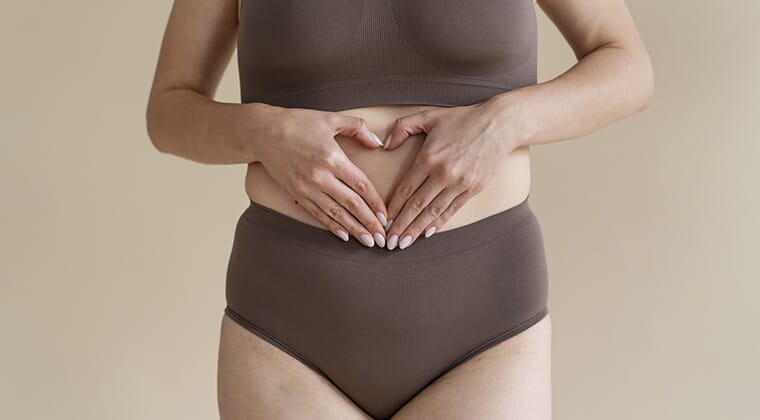This week we feature a blog by our brilliant medical advisors Jessica Farren and Imogen Staveley, looking at what to expect ‘down there’ after birth and how to avoid any issues. They recommend two methods – perineal massage and pelvic floor exercises. It’s worth noting that it’s never too early to start pelvic floor exercises, strong pelvic floor muscles can mean increased sensitivity during sex and stronger orgasms for women.
Vagina changes after birth
When you’re pregnant, you’ll hear a lot said about changes to your body: “you’ll never be able to laugh without crossing your legs”, or “sex will never feel the same”, or how about (ever so helpfully) “it’ll destroy you down there”? You’ll feel like there’s a club of wounded veterans of motherhood, waiting for you to join – and it’s not exactly conducive to enjoying pregnancy or looking forward to the birth process!
The underlying implication is that these changes are inevitable and have to be accepted as part of the lot of a mother.
They are not, and do not.
In this blog, we’re going to cover what you should expect, at least initially, in terms of changes. We’re also going to cover what you can do to minimise the chances of having any problems at all, or ensure they improve as quickly as possible: perineal massage and pelvic floor exercise. Finally, we’ll talk about what to do if you do have any issues after birth.
What is inevitable
It is true that having a baby (and especially lots of babies) can change things.
Your undercarriage will be tired and stretched from nine months of having to hold a baby in, and a few hours of pushing it out. Everything will usually feel a bit sore and odd immediately after you’ve had a baby vaginally. You will find it difficult to ‘engage’ your pelvic floor muscles (see below) for the first few weeks. It is also very normal not to have quite the same control over your bladder and bowels initially – so you may find yourself rushing to the loo, or leaking, especially if you try to exercise. However, all of this should improve incredibly quickly – and by two or three months (by the time you have chance to think about yourself again!) they should not be troubling you.
In the long run, a degree of ‘prolapse’ (which is where the womb, the bladder or the bowel wall descend slightly into the vagina as you get older) is undoubtedly more common in women who have had children than those who have not. Sometimes this requires an operation, especially if it is related to incontinence – though this is rarely required until much later in life. Where you have torn or had a cut during childbirth may not look or feel exactly the same as it did before – but it should not be painful.
Importantly, the vast majority of women do not find any of these changes have any consequence for their quality of life in the long run.
What can I do?
Lots – but it does take time and effort! It’s really hard to stay motivated – because you won’t seeany changes. But it is really worth it – and stays worth it for a long time.
Perineal massage
It’s no surprise that a baby’s head coming through your vagina is a tight fit. Sometimes the fit is just too tight, and tears or cuts (an ‘episiotomy’ is a cut, usually made from the right, lower side of the vagina outwards, during childbirth to prevent uncontrolled tearing) are common – especially with your first baby.
The idea of perineal massage is to stretch the area prior to birth. The perineum is the area of skin between the vagina and the back passage. Massage has conclusively been shown to reduce the risk and severity of tears. Ideally, you should start this by about 35 weeks, and aim to do it four times each week.
Here’s how:
- Make sure your hands are clean and you’ve emptied your bladder
- Some people prefer to have a bath first to help relax and soften the tissue
- Lie on your bed without underwear and a towel underneath you, and your knees bent up
- Lubricate your fingers with some olive or almond oil (there is no evidence to say any special products on the market are any better than what you’ll already have at home)
- Insert two fingers into the vagina and massage the area to the back of the vagina and over the perineum to prepare the area
Now begin the stretching exercises:
- With your thumb inserted, press down on the back wall (6 o clock, towards the back passage) of the vagina. Then, using a sweeping motion, stretch up each side of the vagina so that the whole area (from 3 to 9 o clock) is stretched.
- Apply firm pressure at 4,5, 7 and 8 o clock and stretch in each place until you feel a burning sensation. Then hold in each place for two minutes. Try to relax the muscles while you do this.
Over time you should aim for a more intense and longer stretch.

Some women rave about a product called the EpiNo. It costs £100, and can be bought online. It is essentially as small balloon which is inserted into the vagina and can be inflated using a hand pump. It stretches the perineum in a similar way to perineal massage, and may help replicate the sense of a baby’s head crowning (which may then enable more control when it actually happens!). It can also be used in a slightly different way to monitor the power in pelvic floor exercises before and after labour. Some people find having a piece of kit motivates them to do the massage and the exercises. However, importantly, there is as of yet no conclusive evidence of benefit in trials to support its use: one recent study suggested no difference in tears between women who used EpiNo and those who didn’t (2).
Pelvic floor exercises
The ‘pelvic floor’ is a canopy of muscles that runs from your coccyx (tailbone) to your pubic bone. It is very important in holding your important organs ‘in’ – and in doing so, helping stop any leakage of urine, wind or worse.

Exercising these muscles, both during and after pregnancy, helps strengthen them so that they continue to do their very important job after they have been stretched by childbirth – and significantly reduces the chances of you having any long-term problems with incontinence or prolapse.
You tense your pelvic floor muscles by imagining that you are trying to stop yourself from passing wind. You then ‘pull forwards’ so that you would also stop the flow of urine (you can try this once or twice while actually passing urine to get the feel of it). You should get a sense of ‘drawing up’ the back passage and vagina. It’s important not to tense your buttocks or thighs. You will find that as you get more practice, you will be able to do these exercises anywhere – but initially you are likely to want to practice them lying or sitting down.
You need to exercise these muscles in two ways:
- Slow holds – hold the muscles for as long as you can (ideally 10 seconds) – and then release for 5 seconds. Aim to repeat this ten times.
- Fast squeezes – strong and quick, releasing straight away. Aim to do ten fast squeezes – and repeat three times.
You should aim to do these at least twice per day. It sounds like a lot but should only take five minutes, and you can be watching TV or on your commute. Some people find it helpful to have specific prompt to do them, or to download an app that sends you reminders (I would personally find this irritating – but if it does the job….).
If you think you are having difficulty doing these exercises you may want to ask about being referred to a women’s health physiotherapist – who can show you how to engage the muscles and come up with a tailored programme for you. Often, if you have had a significant tear, you will automatically be referred for physiotherapy, and may even see them before you leave hospital with your baby.
If you do have problems
We’ll talk more about how to look after yourself and any tears or cuts in the first couple of weeks in another post.
However – the important thing to reiterate is that there is absolutely no need to suffer in silence.
In the short term you should speak to your midwife, GP, or return to the maternity assessment area in the hospital you delivered in if you are worried about anything. If it is more sore than you were expecting, they should check for any complications, and provide you with stronger pain relief.
In the longer term, young (or, indeed, old) women should not experience painful sex, feel embarrassed about what their bits look like, or leak urine every time they cough and sneeze just because they have had a baby. If you are experiencing issues, do not brush them under the carpet and accept them as the new normal, and do go and see your GP – who will check things over, and most likely refer you to physiotherapy or gynaecology services.
References
- https://www.scitechnol.com/peer-review/antenatal-perineal-massage-improves-womens-experience-of-childbirth-and-postpartum-recovery-a-review-to-facilitate-provider-and-pa-Cpgl.php?article_id=6038
- Kamisan Atan I, Shek KL, Langer S, Guzman Rojas R, Caudwell‐Hall J, Daly JO, Dietz HP. Does the Epi‐No® birth trainer prevent vaginal birth‐related pelvic floor trauma? A multicentre prospective randomised controlled trial. BJOG 2016; 123:995–1003
- http://physioredcliffe.com.au





